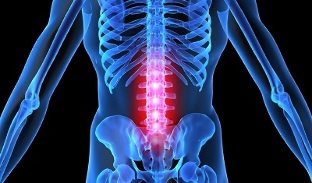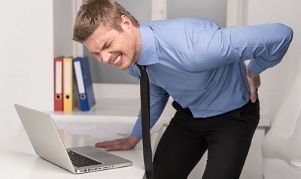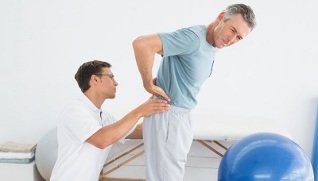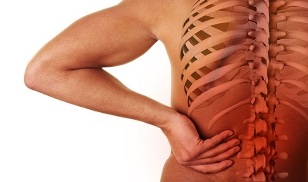Low back pain most often affects people after 35 years. In the vast majority of cases, the disease is associated with a deformation of the vertebrae and its consequences. A timely visit to a doctor will speed up recovery, because the symptoms and treatment of osteochondrosis of the lumbar spine are interrelated concepts.
The more the disease progresses, the more severe its consequences, the more difficult the process of restoring health.
Signs and symptoms of osteochondrosis of the lumbar spine

The lumbar spine is located between the sacrum and the thoracic region and consists of five vertebrae connected by intervertebral discs.
The development of osteochondrosis means the wear and tear of the intervertebral discs, which act as shock absorbers during stress on the spine. The base of the discs is a gel-like mass, protected by a dense fibrous ring and cartilage tissue, and the internal space is filled with a liquid nucleus pulposus.
As the loads on the vertebrae increase, the elasticity and flexibility of the intervertebral discs are lost, as well as their height, and microcracks form in the annulus fibrosus, which eventually lead to its ruptureand damage the nucleus pulposus.
The destruction of tissue is accompanied by pinching of the nerve roots located on both sides of the vertebrae and causes severe pain.
The main signs of lumbar osteochondrosis:
- back pain;
- fatigue and depression;
- excessive muscle weakness or tension;
- loss of sensation in the limbs, buttocks or thighs;
- sharp or aching pains and spasms in the lumbar region, often radiating to the legs;
- violation of motor function.
Against the background of severe damage to the vertebrae in the lumbar region, other symptoms are observed, most often, malfunctions of other organs - the urinary and reproductive system, the gastrointestinal tract.
Causes of occurrence
Like most diseases of the musculoskeletal system, osteochondrosis can develop for many reasons. Some of them are rooted in lifestyle and diet, while the other develops against the background of physiological characteristics of the body.
Quite often, the treatment of osteochondrosis of the lumbosacral spine is required by athletes, whose backs are exposed not only to constant power loads, but also to periodic injuries.

Second category of people at risk, people who, by their profession, spend a lot of time at the same job - teachers, hairdressers, cooks, loaders, waiters, programmers, office workers and drivers.
Among other reasons for the development of pathology:
- overweight; metabolic disorder
- ;
- incorrect posture, bend over;
- genetic predisposition;
- injuries;
- bad habits;
- lack of trace elements and vitamins useful in the diet;
- abnormal development of the musculoskeletal system, flat feet;
- hypothermia;
- lack of mobility, static;
- frequent stress.
All of these factors can affect the elasticity of the intervertebral discs, as they contribute to impaired blood circulation or the appearance of a deficiency of nutrients entering the vertebral tissues.
Vertebrae are able to perform their functions, subject to regular tissue renewal. In the event of malnutrition of the spinal tissues, whether it is a lack of blood circulation or problems with metabolism, the regeneration processes slow down or stop completely. There is therefore a drying out and a dystrophic change in the cartilage and the fibrous ring of the vertebrae.
Degrees of osteochondrosis of the lumbar spine
Depending on the level of spinal injury, there are four degrees of development of osteochondrial processes, which manifest themselves in stages as the disease progresses.
First degree
Pathological processes in the spine begin long before their first clinical manifestation. Due to the loss of moisture, the intervertebral discs become less elastic. The height of the discs remains normal. The patient feels discomfort in the lumbar region.
Second degree

Against a background of moisture deficiency, microcracks appear in the fibrous ring, and inflammation of the tissues develops.
The hook-shaped processes of the vertebrae gradually increase. Seals grow in cartilage.
A patient complains of back pain radiating to the legs or groin. Limitation of motor skills is possible. Malfunctions occur in the work of internal organs.
Third degree
The integrity of the fibrous ring is broken, the intervertebral disc protrudes, forming a herniation. Vessels and nerve endings are compressed. There are muscle spasms, dysfunction of the pelvic organs, sensory disturbances of the lower extremities, prolonged attacks of radiculitis.
Fourth degree
The most difficult, untreatable stage in the course of the disease. As a result of the complete destruction of the intervertebral discs, scars form in their place. The vertebrae come as close as possible and gradually deform. With the development of compression of the spinal cord, paralysis of the lower extremities is possible.
If the timely treatment of osteochondrosis of the lumbar spine is not provided, the destruction of the vertebrae will progress and may lead to disability.
Diagnostics
To recognize a disease and make an accurate diagnosis, neurologists use a combination of measures - taking a history, physiological examination, and device studies.
Take the anamnesis
Provides for the study of patient complaints:
- cause for concern;
- location of the discomfort;
- duration and intensity of unpleasant sensations;
- the duration of the illness;
- possible causes of the disease;
- frequency of exacerbations;
- factors causing exacerbations;
- factors that improve well-being.
In addition, the doctor studies information about the patient's lifestyle, diet, work and rest, the presence of bad habits, hereditary factors and trauma.
Physiological examination

Carried out to identify pathological changes and make a preliminary diagnosis.
During the examination, the doctor assesses the patient's motor skills - gait, posture, range and range of motion. The palpation method examines the condition of the muscles - tone, size, volume, presence of spasms.
Adjusts the sensitivity level with a slight tingling sensation. Tapping with a hammer allows you to recognize the areas of irradiation of pain.
Material studies
To get complete and accurate information about the location of the pathology and the degree of tissue damage, doctors use research using different types of medical equipment.
Radiography.Examination of the lumbar spine by means of radiography allows to establish the anatomical parameters of the vertebrae and intervertebral discs, the tendency to narrow the holes between the bases, the presence of bone growths.
Tomography.The use of electromagnetic waves provides an image of the study area on the screen for further study and analysis of the condition of the vessels supplying spinal tissues, nervous processes andthe intervertebral discs.
CT.X-ray images of several segments of the spine are taken. The image is displayed on the monitor to determine the nature of the changes in the vessels, the membrane of the vertebrae and spinal cord, marginal growths.
For differential diagnosis, various types of research are used to rule out pathologies of other body systems.
Treatment of osteochondrosis of the lumbosacral spine
The duration and characteristics of the treatment of lumbosacral osteochondrosis depend on the results of diagnostic measures. In the early stages of the development of the disease, conservative treatment is indicated. For more complex lesions of the spine, surgical intervention is used.
The optimal therapeutic effect is achieved through complex therapy, which includes the use of topical drugs, physiotherapy, massage and health-enhancing gymnastics.
Drugs
To relieve symptoms, nonsteroidal drugs for internal and external use are prescribed - tablets, injections, ointments. In addition, chondroprotectors, neuroprotectors, diuretics, vitamins, muscle relaxants are used.

Medication helps:
- eliminates pain;
- relieve inflammation;
- relax the muscles;
- restore destroyed cartilage tissue;
- improve blood circulation;
- reduce swelling;
- increase physical activity;
- normalize the nutrition of the brain.
For acute pain, novocaine blockade is used, which provides instant action.
Folk remedies
Traditional treatment is effective in addition to drug treatment. The main methods of traditional medicine are based on the use of plant materials, animal products and chemicals.
On the basis of various components, ointments and compresses, decoctions and infusions are prepared, used for internal and external use, as well as for medicinal baths.
Physiotherapy for lumbar osteochondrosis
Physiotherapy procedures are a great way to restore motor functions in the spine after osteochondrosis.
The main methods of physiotherapy are:
- electrotherapy- exposure to weak electric currents to improve blood circulation in the tissues;
- magnetotherapy- the use of the properties of the magnetic field to restore tissues at the cellular level;
- laser therapy- complex activation of biological processes in vertebral tissues and nerve endings;
- shock wave therapy- improvement of microcirculation and metabolic processes in tissues affected by the effect of an acoustic wave;
- balneotherapy- using the healing properties of mineral water.
Physiotherapy procedures not only repeatedly increase the effectiveness of drug therapy, but also contribute to healing and strengthening of the body as a whole.
Massage for osteochondrosis of the lumbar region
Visiting massages is one of the most enjoyable and effective methods of treating osteochondrosis.
With massage therapy:
- eliminate muscle spasms;
- improve blood supply to affected areas;
- improves lymphatic flow;
- restore muscles that have suffered atrophy;
- removes limitation on mobility.
Massage is prescribed when pain syndromes are eliminated.
Catch-up gymnastics
The main task of exercise therapy for osteochondrosis is to restore the functionality of the spine and correct it. However, you can only attend classes after eliminating the symptoms of exacerbation.
The most effective methods of medical gymnastics are:
- load;
- visit to the gymnasium;
- water therapy, swimming.
A hoop can be used for sports at home. Some doctors recommend yoga to their patients to restore flexibility to the spine.
Exercises for exacerbation of lumbar osteochondrosis
All osteochondrosis exercises should be performed slowly and without sudden movements.
To strengthen the muscles that support the vertebrae, appropriate exercises performed while lying on your stomach. In this case, the arms are raised with a slight stretch, but without tension. Repeat 4 times.
Surgery
The spine is treated with surgery in particularly difficult cases - with significant neurological disorders, as well as with loss of control of the stool.
During surgery, the source of the disease is eliminated and measures are taken to stabilize the spine. The postoperative period lasts several months.
Why is lumbar osteochondrosis dangerous?

The degenerative changes that occur in lumbar osteochondrosis contribute to the development of many life-threatening diseases. Against the background of an intervertebral hernia, protuberances, lumbago and sciatica occur.
Further progress of the disease may cause the intervertebral disc to prolapse and the formation of spinosis. In addition to the severe pain accompanying the pathology, the motor skills of a person are disturbed, until their complete loss. Paralysis of the lower extremities develops.
Death is inevitable if there is extensive damage to the lining of the spinal cord.
Prevention
To avoid devastating spinal changes, you need to adopt a healthy lifestyle:
- playing sports - swimming, soaking;
- to adhere to a balanced and nutritious diet;
- eliminate bad habits;
- maintain posture;
- support the spine during sleep with an orthopedic mattress.
In addition, it is advisable to avoid hypothermia, heavy lifting. Women are advised not to wear high heel shoes frequently.
You can keep your lower back healthy if you adjust your lifestyle and don't forget the importance of physical activity.





































